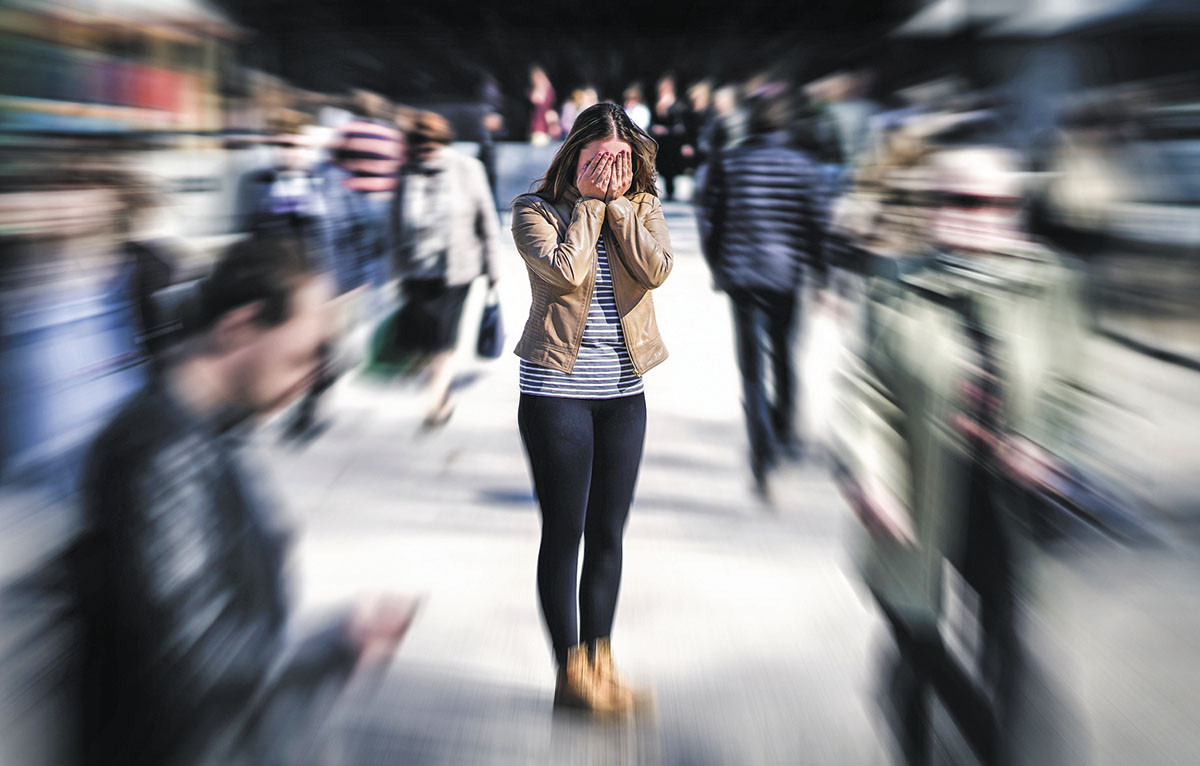Anxiety overload
Physical signs of anxiety can provoke alarm and avoidance. But you can learn how to thrive.
- Reviewed by Toni Golen, MD, Editor in Chief, Harvard Women's Health Watch; Editorial Advisory Board Member, Harvard Health Publishing; Contributor

The emotional signs of anxiety — nervousness, restlessness, distraction, a clenched jaw — almost always occur in tandem with physical symptoms such as dry mouth, nausea, or sweaty hands, which can then magnify our anxious feelings. When anxiety crosses a line, however — unique to each individual — everyday stressors can translate into disruptive physical symptoms that make it difficult to live normally.
Profound anxiety can provoke everything from dizziness and diarrhea to heart-pounding panic that leaves you gasping for breath. "If you're feeling lightheaded, your heart racing and chest tightening, it really contributes to a sense that something terrible is going to happen," says Jacqueline Bullis, an assistant psychologist in the Division of Depression and Anxiety Disorders at Harvard-affiliated McLean Hospital.
"But physical symptoms themselves aren't the problem," Bullis says. "It's really the way we respond to them. We want people to learn that these distressing physical sensations aren't dangerous and they can learn ways to tolerate them."
Hitting the panic button
Anxiety in itself can prove useful under the right circumstances — spurring us, for example, to make sure we're prepared for that big presentation at work. "When it's at that Goldilocks spot where it's not too intense or too suppressed, anxiety motivates us," Bullis says. "If we were never anxious, we wouldn't get anything done."
Extreme physical sensations, however, stem from the body's fight-or-flight response. In those moments, we might react the same way to a perceived threat — like public speaking — as we would to real danger, such as a home intruder. During an anxiety attack, symptoms can turn so dramatic that people believe they're having a heart attack or stroke.
"People having severe anxiety attacks almost universally feel they're about to die," says Dr. Arthur Barsky, a psychiatrist at Harvard-affiliated Brigham and Women's Hospital. "They experience it as an impending medical emergency rather than anxiety, which is going to worry them even more. It becomes a self-fulfilling prophecy."
You should always seek a doctor's advice for any potentially dangerous symptoms, such as chest pain or shortness of breath, to make sure anxiety is indeed the root cause. But once that's established, your next task is learning how to respond in situations you know will hit your panic button. Many people will avoid common scenarios and retreat from potentially unpleasant interactions to stop anxiety before it starts — but limit their lives in the process. This is the wrong approach, Harvard experts say.
CBT: The gold standard
What's the best path to overcome severe anxiety? Cognitive behavioral therapy (CBT) is considered the gold standard, effective in many cases. Often, people wait too long — even decades — only to be astonished how quickly they can gain control of symptoms using CBT, Bullis says. Results typically take four to six months.
A form of CBT called exposure therapy engages you in activities designed to provoke uncomfortable physical sensations, causing you to become breathless or feel momentarily panicked. "We're going to be confronting things you've gotten good at avoiding," Bullis says. "The more you do it, the more used to it you get. It's kind of like a vaccine — by repeatedly and deliberately exposing yourself to these scary physical sensations, you can reduce the impact they have on you in the real world."
Short-acting medications, such as beta blockers or benzodiazepines, can be used for situational anxiety to calm extreme physical reactions. But "the problem with these medications is they may reinforce the idea that these symptoms are dangerous," Bullis says. "And many people don't like being reliant on something to help them cope."
A combination of therapies may be needed for severe cases. Bullis recommends seeking a therapist trained in CBT and asking what approaches he or she would use in your treatment. For help locating a skilled therapist, use online search tools provided by the Association for Behavioral and Cognitive Therapies (www.abct.org; look for the "Find a CBT therapist" button) and the Anxiety and Depression Association of America (www.adaa.org, under the "Find help" tab).
Image: © 1033774292/Getty Images
About the Author

Maureen Salamon, Executive Editor, Harvard Women's Health Watch
About the Reviewer

Toni Golen, MD, Editor in Chief, Harvard Women's Health Watch; Editorial Advisory Board Member, Harvard Health Publishing; Contributor
Disclaimer:
As a service to our readers, Harvard Health Publishing provides access to our library of archived content. Please note the date of last review or update on all articles.
No content on this site, regardless of date, should ever be used as a substitute for direct medical advice from your doctor or other qualified clinician.
















